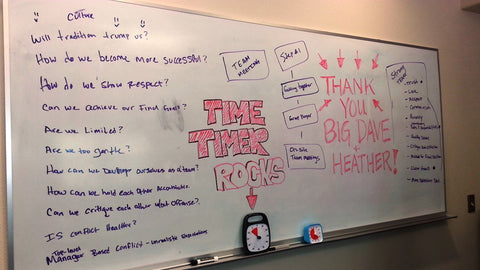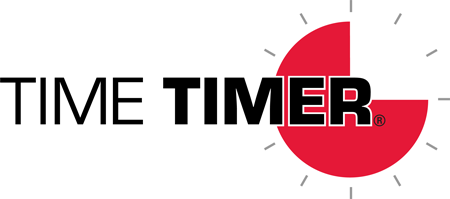
Stephanie Davison and Charles Garrison work on the communications team for Faith Comes by Hearing, a nonprofit that brings together global communities through free Audio Bibles in nearly 1,000 languages.
On a day he was at home sick, Garrison, who leads web development, read the book “Sprint: How to Solve Big Problems and Test New Ideas in Just Five Days” by Jake Knapp.
Garrison shared the idea of a “Sprint” with coworker Davison, a writer, when he returned to work, suggesting it could help encourage innovation and collaboration on their team. One important aspect to Garrison that was mentioned in the book was the use of a Time Timer®, the visual timer featured in the book helps keep design Sprints on track.
“Wait; I know the guy who makes that,” Davison said.
Davison and Time Timer® CEO Dave Rogers previously worked together at Trout Unlimited. She contacted Rogers about getting some Time Timer visual timers for her team, and then they set about Sprinting.
“It was a great process all the way through, from concept to Sprint,” Davison said. The communications team conducted a Sprint as a build-on to an offsite retreat. They focused on how to integrate internal and external communications in preparation for a campaign later this year.

Garrison served as facilitator, ensuring the team stayed on track. They spent four hours during the off-site retreat sketching ideas and dot voting on them. The communications team’s manager also participated in this Sprint, and was the final decision maker on the ideas presented within the sketches.
“The Time Timer® was really effective for facilitating our Sprint,” explained Garrison. “The visual component is so important. They could see time ticking away, and I could refer to the timer as a soft reminder. It really helped people stay on task and prevented us from going down rabbit holes.”
The Time Timer® was also important for helping the team adjust on the fly to what was most important and spend time where it was most needed based on team dynamics.
“You never know what a group dynamic will be until you get into it,” Davison said. “You don’t want to shut down a really good conversation or idea. He [Garrison] did a great job as a facilitator with staging that.”
Dot voting was also beneficial for enabling the team to look at ideas silently and prevent unnecessary debate that zaps productivity. Instead, they focused on creativity.
The team can’t wait to do more Sprints and are planning to continue them beyond their campaign ideation this fall. When they do, they will continue using their Time Timer®.
“Sprint and Time Timer® are a match made in heaven,” Davison said.
Advice for Your First Sprint:
-
Focus on one major concept at a time.
If you don’t have the concept, use the first Sprint to discover the concept. For this Sprint, they focused on an upcoming external campaign but will lead future Sprints on different aspects of the overall campaign.
-
Utilize a Time Timer
Use a Time Timer visual timer and a facilitator to keep things on track and enable time for all participants to voice their ideas.
-
Sprint offsite.
An external location is especially important for a team that serves many internal departments. It enables your team to be fully present with their ideas. It’s also a neutral ground for all participants.
Want to learn more about Design Sprints? Read Sprint by Jake Knapp and check out his Special Edition Time Timer here.
